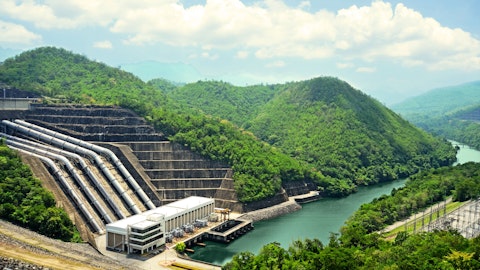Julien Dumoulin-Smith: Hey, just going back to the last question a bit, how do you think about the composition of the $25 billion to $35 billion of project tax equity and tax credit transferability, how do you think about your existing tax equity commitments, and how do you think about some of the impacts from a regulatory perspective on the tax equity market? Obviously, you’re talking about a robust start to the tax credit transferability. How much does it matter? How much does it play into that $25 billion to $35 billion, and ultimately, how much TE is contemplated anyway in that range, if you will?
John Ketchum: Yeah, I’ll go ahead and take that, Julien. First of all, when you look at our tax equity project finance split, things can move around. Let’s just hypothetically think about it as kind of 50-50. I think that might be a decent starting place to think about and we feel very good about our ability to be able to access tax equity. the regulatory issues, I think, that you pointed out, I think, are going to get resolved. I think there were some unintended consequences around Basel III, and we have had significant discussions with the folks involved. On those issues, the administration certainly thinks this was an unintended consequence, as do, I think, folks at the Fed and the administration, I think, is very focused on trying to get a good resolution around it.
But, I don’t worry about it too much at the end of the day for us. I think the Basel III thing gets fixed and, worst-case scenario, the banks will find other pockets to be able to issue tax equity. We’ll be issue — we’ll receive our allocation off the top of the deck like we always do. And, these relationships that I just spoke about with corporate parties, these 50 folks or so that we’ve been dealing with, there’s no reason they can’t step in and provide tax equity financing. And we’ll be talking to them about those structures as well and then transferability, which we’ve already spent some time talking about this morning, can fill any gap. So long story short, we feel terrific about our ability to source tax equity financing going forward.
Julien Dumoulin-Smith: Got it. So transferability is not technically part of the $25 billion to $35 billion, but obviously it’s a fluid conversation, right, if I understand that piece.
John Ketchum: Can you say that again, Julien?
Julien Dumoulin-Smith: The transferability, the credit transferability, technically not included in that $25 billion to $35 billion as it stands, but it’s a fluid question of how you finance going forward.
John Ketchum: Yeah. The tax transferability is not in that number. Again, it shows up in cash flow from operations and then the equity content that’s created really shows up in that corporate debt issuance line, but look at the corporate-the cash flow from operations in terms of the dollars that we’re receiving for tax credit transfers.
Julien Dumoulin-Smith: Yeah. And then just quickly, if I can, on the interest rate question here, thank you again for the additional sensitivities and disclosures here. How do you think about sort of a baseline and the open impact as you roll to kind of 2026? I think it’s notable, for instance, you guys reaffirmed through that period with your usual commentary. How do you think about sort of the puts and takes as you roll into that longer dated ’26 period, considering the roll off of the hedges here in that, I think, period more specifically, if you will? Is there a way to kind of quantify the interest rate kind of head one?
John Ketchum: Yeah. So a couple of points I’ll make. One is you’ve seen the sensitivity. So zero impact in ’23 or ’24, $0.03 to $0.05 in ’25 and ’26. With the five year to 10 year tenors, with the average coupon 375 basis points, we feel very good about the protection that we have there. We’ve talked about where FPL sits. And then you think about the project financings that we entered into. We use those hedges. Those project financings are basically 20 year amortizing debt that have 20 year hedges that then get rolled into them that have the benefit of those swaps and so when you think about our existing project finance portfolio that we have, there’s another $4 billion of interest rate swaps that aren’t even in the $20.5 billion that we mentioned to you today that protect and safeguard those as they roll and do.
So long story short, between the $20.5 billion that we have against the backlog the fact that our existing portfolio is already locked in and hedged, we feel very good about our interest rate exposure.
Julien Dumoulin-Smith: Got it. Excellent. All right, guys. Thank you very much. I’ll pass it there. Have a nice one.
Operator: Our next question comes from Carly Davenport with Goldman Sachs. Please go ahead.
Carly Davenport: Hey, good morning. Thanks for taking the questions. Appreciate the incremental disclosure on the funding plan and the asset sales and just to follow up there. Are renewables the only element kind of embedded in that $3 billion in proceeds, or are there any other non-core assets and energy resources that you’d consider monetizing?
John Ketchum: Yeah. So when I think about it, Carly, renewables come top of mind. We’ve had a history over the last several years of being able to recycle capital through renewables. But remember, too, we’re a large company. There are other assets that could potentially be available for capital recycling that are non-core. The FCG transaction that we just recently announced is a good example of that and we’ll always look for opportunities. If there are situations where third parties value assets more than we do, then sure, we’ll look to be opportunistic, but it’s not a core part of the plan.
Carly Davenport: Got it. Okay, great. That’s helpful. And then just as you think about the timing cadence of the backlog additions and also the dispersion across the different technologies, I think, Rebecca, you alluded to the fact that the 4Q pipeline is shaping up to be kind of more weighted to the ’24 timeframe to ’26 timeframe versus this quarter being a little bit longer dated. But can you also just talk about the split across wind, solar, and storage? It seems like there’s been step up in solar relative to wind. So just any thoughts on how you see that piece evolving going forward would be helpful.
Rebecca Kujawa: Thanks, Carly. It’s a great question. Yes, I definitely support that first part of your comment. And it’s consistent with what I had said before that I think this quarter was a little bit anomalous in terms of the waiting to 2027 and the pipeline is very much more weighted for what I see today for ’24, ’25, and ’26, with much of it in the ’25 and ’26 timeframe, just given the fact that we’re ending into ’24. In terms of the technology, obviously, we had very strong findings for storage and as Kirk highlighted in the prepared remarks, in terms of the — maybe not surprise is probably not the right word, but really pleased to see how we’re starting to see adoption across a broader set of markets, not just California, but into the Midwest, where our utility customers and obviously some of the C&I are really valuing the ability to incorporate storage for capacity value and affirming and shaping the renewables product.
So that’s really positive in my mind. On the wind side, I think we’re still seeing a little bit of dynamics that shaped up as a result of the tax credits that we originally we and the industry – thought were going to phase down after 2020. So we saw a significant amount of pull forward of demand. And I think that’s still affecting the industry a little bit and then, obviously, the PTC being extended for solar significantly improved the economics from a relative standpoint, which has been super positive for demand. We still see a lot of geographies where wind is incredibly attractive and so I feel good about long-term demand for wind and I also feel really good about long-term demand for repowering projects. Obviously, we had a great start to the repowering initiative following the IRA extension with over 700 megawatts we talked about today.





